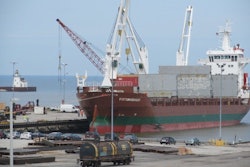Now that the harvest is over, grain is pouring into Will County where it will be loaded into cargo containers and shipped around the world.
Most of the corn and soybeans will head west to the Pacific where it will travel on ships to Asia to feed cattle and hogs and be turned into food products.
About 60 million bushels of grain will go through two rail intermodals this year, more than anyone could have ever dreamed a decade ago before the first intermodal, BNSF Logistics Park-Chicago opened in 2002 in Elwood. Union Pacific's Global Four opened in 2010 in Joliet.
The amount of grain shipped from the two intermodals has doubled in the past five years and now amounts to about 20 percent of all corn and soybeans exported from Illinois, said Jeremy Grey, vice president for infrastructure and transportation for Oak Brook-based CenterPoint Properties, which developed the intermodals and the surrounding business parks.
The operation has grown so big, Clinton, WI-based DeLong Co., the country's largest grain exporter, moved local operations into Union Pacific's intermodal park this summer to be closer to the train lines, Grey said. About a year ago, Minneapolis, MN-based Cargill Inc., another large grain distributor, moved into the BNSF intermodal park.
Years ago, local grain would be loaded into barges for export. But once the BNSF intermodal opened, everything changed. Sending grain by cargo containers that are transferred from truck to train then ship is a relatively new concept for the area, Grey said. And many Asian countries are hungry for more meat and more protein that the grain can provide, he added.
"It's truly one of the few products we produce in the United States and send overseas," he said.
About 85 percent to 90 percent of the grain is grown for the export market, compared to 55 percent to 60 percent a couple of decades ago, said Mark Schneidewind, manager of the Will County Farm Bureau.
One new wrinkle in the local grain export business is the creation of high-protein corn cakes from the byproduct of ethanol production in Rochelle, said John Greuling, president and CEO of the Will County Center for Economic Development.
Wet mash left over during the creation of ethanol is dried so it will not spoil during transport to Will County and beyond. The DDG, or dried distillers grain, is then mixed with bean meal and corn and made into cakes that are fed to cattle overseas.
"There's a big demand for that," Greuling said. "Now that there is an emerging middle class in China, they are demanding higher quality food and more beef and pork."
Some grain stays local and is sent to the J.R. Short Milling Co., a food processing plant near Kankakee, that churns out ingredients for Taco Bell's cinnamon twists, Schneidewind said.
Years ago, more grain stayed in the area to feed livestock. But in the past 20 years, local livestock numbers have dwindled as more land was developed, Schneidewind said.
"The only thing that's really growing in livestock is horses," he said.
The popularity of ordering grain by my cargo container is soaring because the county's only two barge terminals have closed and some customers like ordering the smaller container loads, Schneidewind said.
A barge load of grain had to be 55,000-60,000 bushels. But individual cargo containers hold 1,000 bushels.
Prairie Creek Grain Co. first started shipping by cargo container and rail in 2004, said manager John Hinrichs. "It was a new way to deliver grain overseas," he said.
Customers like getting their grain in cargo containers because it's easier to distribute to end users, he added. Those same customers are willing to pay a premium for the convenience of having smaller loads, Schneidewind said.
The premium can amount to 20 cents per bushel, which has attracted more grain to the intermodals.
As this new business of shipping grain by cargo container evolves, better ways are being developed to load the containers. Farmers used to have to wait 90 minutes to an hour at the grain elevators.
"Now they can just dump the grain and go," Schneidewind said.
Grain comes to Will County's two intermodals from Indiana and Wisconsin as well as a dozen other Illinois counties.
"People are hauling it down here because of the prices," Schneidewind said.
Schneidewind said grain exporters are now looking for ways to put cargo containers onto barges in addition to trains. That's good for the barge industry, good for competition and good for prices, he said.
"We need to maintain both of those markets," Schneidewind said.
Years ago, when the first intermodal was created in Joliet, local officials worried empty cargo containers would stack up in the area. That didn't happen. Instead of being a nuisance, they turned into an opportunity to send more grain overseas.
"Basically, the way it has grown has surprised everybody in our industry," Schneidewind said.
If someone asked him 10 years ago to predict how much grain would be shipped from the area by cargo containers, Schneidewind said he would have estimated 20 million bushels — not 60 million.
"I wouldn't have even come close."
Source: The Herald-News



















